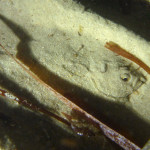During a walk through the shallows at Glenelg North beach after 9.30 pm last night, in knee-deep water, Emma and I were delighted to spot a numbers of small (likely juvenile) flounder. The animals were each less than 10 cm in length and sported fine, uniform sandy patterns which allowed them to practically disappear on pale, sandy bottom. When startled by our lights or movement, the animals escaped swiftly, hugging the contours of the sandy ‘dunes’. On settling, they would sometimes shuffle into the sand, partially burying themselves. We were able to capture a few photographs of the animals, which show their remarkable cryptic qualities.
The following day, we decided to look the animal up and see if we could accurately identify the species of flounder seen. Thanks to the invaluable database of the Atlas of Living Australia, we soon learned that at least 15 species of flounder have been recorded in South Australian waters.
Of the fifteen, only three species have been recorded inshore along the coast of suburban Adelaide- the spotted, longsnout and greenback flounders. The latter was also the most commonly recorded in South Australia. I made a tentative identification (spotted flounder) and forwarded some photos to two knowledgeable and supportive icthyologists: Mark McGrouther at the Australian Museum, and Ralph Foster at the South Australian Museum. I am confident that both of them would be happy to assist you in identifying any local fish sighting.
Unfortunately, juvenile fishes are not as commonly illustrated in photographic guides, and the appearances of the animals can often change as they age- shape, proportions and pigmentation- further complicating the process of identification.
After filtering the ALA’s ‘flounder’ search results by limiting the query to South Australian records, I was able to produce the following table which will hopefully be of use to others who find themselves confounded by an unfamiliar flounder. It would appear that several of the South Australian populations of these species appear isolated from other populations on Australia’s eastern coast. Largetooth, smalltooth and slender flounders are the obvious examples and could be worthy candidates for future genetic or population studies.
| Genus | Species | Common name | No. of records* | First dated SA record** | Most recent record |
| Ammotretis | brevipinnis | Shortfin flounder | 4 | 1981 | 2015 |
| Ammotretis | elongatus | Elongate flounder | 20 | 1973 | 2015 |
| Ammotretis | lituratus | Spotted flounder | 7 | 1909 | 2015 |
| Ammotretis | rostratus | Longsnout flounder | 28 | 1909 | 2015 |
| Arnoglossus | bassensis | Bass Strait flounder | 8 | 1990 | 2015 |
| Arnoglossus | micrommatus | Smalleye flounder | 5 | 2005 | 2007 |
| Arnoglossus | muelleri | Mueller’s flounder | 10 | 1981 | 2005 |
| Azygopus | pinnifasciatus | Banded-fin flounder | 1 | 1913 | 1913 |
| Lophonectes | gallus | Crested flounder | 8 | 1909 | 2015 |
| Psettina | gigantea | Combscale flounder | 1 | 1981 | 1981 |
| Pseudorhombus | arsius | Largetooth flounder | 8 | 1978 | 2007 |
| Pseudorhombus | jenynsii | Smalltooth flounder | 44 | 1932 | 2015 |
| Pseudorhombus | tenuirastrum | Slender Flounder | 1 | 2015 | 2015 |
| Rhombosolea | tapirina | Greenback flounder | 78 | 1921 | 2015 |
| Taratretis | derwentensis | Derwent flounder | 13 | 1981 | 1994 |
I am hopeful that little by little, members of the Marine Life Society of South Australia will be able to increase the scant number of images and sighting records the ALA currently presents for the above species. Each species is linked to its corresponding page on the Atlas for further information, images and to make it easy to report sightings of your own.
* The number of records for each species in the above table may include duplicate listings of the same record, when reported by different institutions. In these cases, the number of records could be overstated by up to 2 times.
** The ‘First dated record’ may not be absolute, but represents the only verifiable date currently available via ALA. In some cases, older records may exist, but collection date data has not been entered, has been lost or was never recorded.



